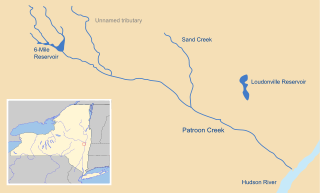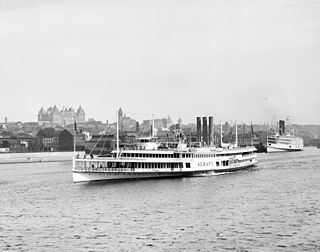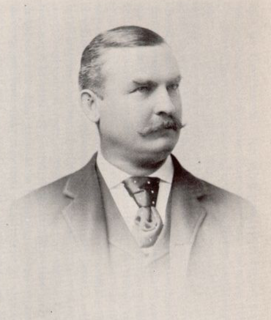The lumber district of Albany, New York was relatively small in the 1830s with around six wholesale lumber merchants, but by the 1870s Albany was the largest lumber district in the United States by value, though by that time it had recently been outstripped in feet sold by Chicago. [1] For about a quarter century in the middle of the 19th century the Albany lumber district was considered the largest white pine wholesale market. [2] There were 3,963 sawmills operating in the lumber district in 1865 but by 1900 there were only around 150. [3] A fire ripped through the district in 1908 signalling the decline of the lumber industry for Albany.
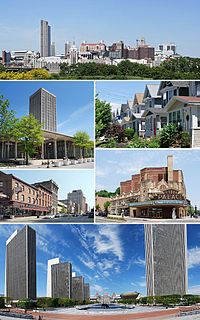
Albany is the capital of the U.S. state of New York and the seat of Albany County. Albany is located on the west bank of the Hudson River approximately 10 miles (16 km) south of its confluence with the Mohawk River and approximately 135 miles (220 km) north of New York City.

New York is a state in the Northeastern United States. New York was one of the original thirteen colonies that formed the United States. With an estimated 19.54 million residents in 2018, it is the fourth most populous state. In order to distinguish the state from the city with the same name, it is sometimes referred to as New York State.

Chicago, officially the City of Chicago, is the most populous city in Illinois, as well as the third most populous city in the United States. With an estimated population of 2,705,994 (2018), it is the most populous city in the Midwest. Chicago is the county seat of Cook County, the second most populous county in the United States, with small portions of the city extending westward into neighboring DuPage County. It is the principal city of the Chicago metropolitan area, often referred to as Chicagoland. At nearly 10 million people, the metropolitan area is the third-largest in the United States.

The lumber district was considered to be the land from North Ferry Street north for about 1½ miles and from the Erie Canal on the west to the Hudson River on the east. It was about 500 feet (150 m) wide at the southern end and 1,150 feet (350 m) wide at the northern end and constituted over 100 acres (0.40 km2). Thirty-one slips connected to the canal and ran east to within 150 feet (46 m) of the Hudson, the longest slip being 1,000 feet (300 m) long.

The Erie Canal is a canal in New York, United States that is part of the east–west, cross-state route of the New York State Canal System. Originally, it ran 363 miles (584 km) from where Albany meets the Hudson River to where Buffalo meets Lake Erie. It was built to create a navigable water route from New York City and the Atlantic Ocean to the Great Lakes. When completed in 1825, it was the second longest canal in the world and greatly affected the development and economy of New York, New York City, and the United States.
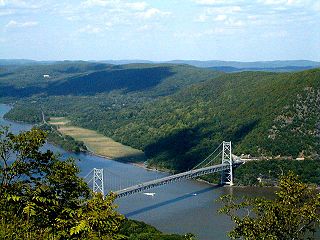
The Hudson River is a 315-mile (507 km) river that flows from north to south primarily through eastern New York in the United States. The river originates in the Adirondack Mountains of Upstate New York, flows southward through the Hudson Valley to the Upper New York Bay between New York City and Jersey City. It eventually drains into the Atlantic Ocean at New York Harbor. The river serves as a political boundary between the states of New Jersey and New York at its southern end. Further north, it marks local boundaries between several New York counties. The lower half of the river is a tidal estuary, deeper than the body of water into which it flows, occupying the Hudson Fjord, an inlet which formed during the most recent period of North American glaciation, estimated at 26,000 to 13,300 years ago. Tidal waters influence the Hudson's flow from as far north as the city of Troy.


When the Albany Basin was constructed in 1825 the pier separating the basin from the Hudson River was the quickly turned into a prestigious place for the lumber industry in Albany, [4] which dates back to the arrival of a millwright and two sawyers in 1630 and the first sawmill in 1654. [5] Until 1848 it continued to be considered the headquarters of the lumber trade in the city, [4] even as the industry moved to the area between Quackenbush Street and the Columbia Street Bridge. [1] The future lumber district at this time was owned by the Patroon Stephen Van Rensselaer and his brother William, and consisted of mostly vegetable gardens that paid little in the way of rent. [6] The Patroon was approached about building slips off the canal for the use of the lumber industry in return for a more ample amount of rent. [6] Originally the Patroon bore the cost of constructing the slips, but as time went on the lumber dealer took upon himself the cost of the slip in return for keeping the rent until such time as construction costs were paid for, at which time the dealer had to start paying rent to the Patroon as everyone else did. It took roughly eight years for the slip to be paid off. [7] During the winter months when the slips were ice-bound and the offices closed, the lumber district virtually abandoned. [8] The inspection system used in Albany for the white pine was the first inspection system for lumber and the model for many other systems. [9]
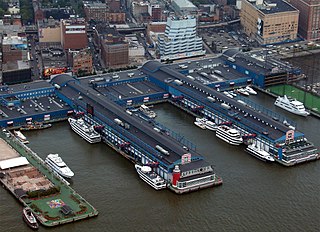
A pier is a raised structure in a body of water, typically supported by well-spaced piles or pillars. Bridges, buildings, and walkways may all be supported by piers. Their open structure allows tides and currents to flow relatively unhindered, whereas the more solid foundations of a quay or the closely spaced piles of a wharf can act as a breakwater, and are consequently more liable to silting. Piers can range in size and complexity from a simple lightweight wooden structure to major structures extended over 1,600 m (5,200 ft). In American English, a pier may be synonymous with a dock.
In the United States, a patroon was a landholder with manorial rights to large tracts of land in the 17th century Dutch colony of New Netherland on the east coast of North America. Through the Charter of Freedoms and Exemptions of 1629, the Dutch West India Company first started to grant this title and land to some of its invested members. These inducements to foster colonization and settlement are the basis for the patroon system. In 1775, at the outbreak of the American Revolution, primogeniture and feudal tenure were abolished and thus patroons and manors evolved into simply large estates subject to division and leases.
At first the supplies of white pine were from within New York, in Allegany and Chemung counties. When those became over-harvested the supply shifted to southern Ontario, and after 1856 from Michigan where Albany buyers held the monopoly on the good white pine. [10] The primary markets were the city of New York and New Jersey. [7] The Albany market also had for a time foreign markets such as Argentina, Chile, and Australia. [11]
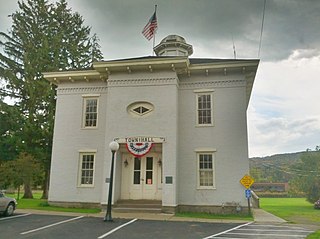
Allegany County is a county in the southern tier of the U.S. state of New York. As of the 2010 census, the population was 48,946. Its county seat is Belmont. Its name derives from a Lenape word, applied by European-American settlers of Western New York State to a trail that followed the Allegheny River; they also named the county after this.
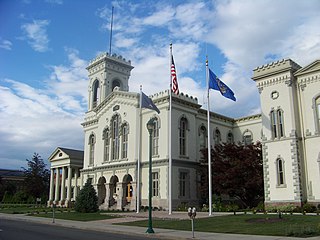
Chemung County is a county in the southern tier of the U.S. state of New York. As of the 2010 census, the population was 88,830. Its county seat is Elmira. Its name is derived from a Delaware Indian village whose name meant "big horn".

Ontario is one of the 13 provinces and territories of Canada. Located in Central Canada, it is Canada's most populous province accounting for 38.3 percent of the country's population, and is the second-largest province in total area. Ontario is fourth-largest jurisdiction in total area when the territories of the Northwest Territories and Nunavut are included. It is home to the nation's capital city, Ottawa, and the nation's most populous city, Toronto, which is also Ontario's provincial capital.
The lumber district had its own dining saloon, telegraph office, a chapel, and several stores. For fire protection there were many fire hydrants and thousands of feet of fire hose. [12] The lumber district did not have any track facilities connecting it to the railroads that fed into Albany until 1906 due to fears that the locomotives would spark a fire. [13]

A fire hydrant is a connection point by which firefighters can tap into a water supply. It is a component of active fire protection.
A fire hose is a high-pressure hose that carries water or other fire retardant to a fire to extinguish it. Outdoors, it attaches either to a fire engine or a fire hydrant. Indoors, it can permanently attach to a building's standpipe or plumbing system.
The eastern part of Arbor Hill around Ten Broeck Street became home to many of the wealthiest lumber merchants in Albany, where they proceeded to build grand rowhouses overlooking the lumber district, Erie Canal, and Hudson River. [14]








